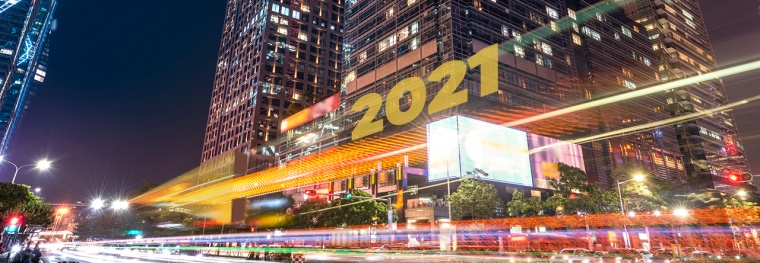Top 10 Security Industry Trends in 2021
In spite of a highly unusual 2020, the security industry’s constant transformation has not stopped. Several significant shifts in the use of technology are even accelerating – for example the increasing of multi-perception technologies, the convergence of security systems, the popularity of artificial intelligence, and the rise of cloud solutions.

These changes are expanding and reshaping the scope of the security industry, from keeping people and assets safe to creating more secure, efficient and intelligent environments.
Looking ahead at 2021, we have high hopes, and Hikvision shares some encouraging ideas and thoughts here regarding key trends that may affect the security industry in both the short- and long-term.
- Intelligent video technology helping during the pandemic
In the face of the Covis-19 pandemic, businesses are prioritizing finding ways to resume operations safely. Intelligent video technology has shown great potential to help companies keep their employees and customers safe while getting back to work.
Powered by AI, security cameras monitor densely populated locations to ensure employees follow vital safety precautions – including social distancing, mask wearing and flow control – and provide initial temperature screenings.
Employees are avoiding unnecessary physical contact with shared hardware in this tense era, accelerating the touchless access control system trend we have seen in the market. Numerous modes of touchless verification – face recognition, palmprint recognition, NFC and QR codes – are being heavily promoted.
- Multi-dimensional perception
For a long time, capturing visual images was the core and only perception capability for video security systems. But with the development and application of sensing technologies, more powerful edge computing and intelligent algorithms, integrated security devices and systems that employ multiple sensors are becoming possible. Now, more perception capabilities, such as radar detection, multispectral imagery, humidity and temperature measurement, and gas pressure detection, are being integrated with video cameras and systems. This integration extends perception capabilities of these video cameras and systems, and widens their applications by enabling the collection and use of multi-dimensional information.
For example, a promising approach right now integrates cameras with centimeter- and millimeter-wave radar technology, which can extend perception beyond the visual range to object detection and movement tracking up to and over 100 meters in the distance. Multispectral imagery is another good approach for cameras to perceive information from the non-visible light spectrum. For instance, innovative ultraviolet (UV) detection boosts the perception capabilities of cameras as far as even capturing invisible electric arc phenomena; this technology finds a key application in safety-checks at aging power grids.
Multi-dimensional perception capabilities will play a fundamental role in taking the video security industry to the next level, and we constantly see growing numbers of integrated security devices and systems with multiple sensors.
- Visibility – Any time, any condition
Users have come to expect uninterrupted performance from their video cameras, regardless of season, the weather, and certainly the time of day. It’s vital to have cameras that can respond effectively to capture clear images, no matter what time of day or night or how bad the weather is.
Nowadays, low light imaging technology that provides colorful images in dark environments and at night is becoming popular in the security industry, and customers have shown a preference toward cameras with color imaging 24/7. More front-end cameras are now equipped with low light imaging technology to make sure they can “see” and reproduce image color both day and night.
And in other extreme conditions such as heavy rain, snow, fog or smog, how do cameras ensure visibility? Industry professionals are tending to choose thermal imaging that measures heat – or thermal radiation – to generate images from their field of view. With thermal imaging, the rendered image is far less affected by even the most light-obscuring of these conditions.
- 5G technology for UHD and wireless video security
5G technology may bring great changes to the security industry. 5G’s greater bandwidth and lower latency makes the regular transmission of high quality images possible, and, with the widespread adoption of ultra-high-definition (UHD) cameras, could bring new opportunities for video security.
Furthermore, reliable wireless transmission over 5G technology will revolutionize the currently-wired video security market. In the forthcoming 5G networks, wireless cameras will proliferate, and more edge devices will be connected in remote locations. This will also facilitate wide and fast deployment of AI applications in edge devices.
- Convergence of multiple security systems
We operate in an industry where users expect comprehensive solutions. The concept of systems working seamlessly together has long been desired by the vast majority of security professionals.
The benefits of converging multiple security systems – including video, access control, alarm, fire prevent and emergency management – into a unified platform are manifold, with efficiency and cost-effectiveness the most obvious. For example, when an alarm goes off, an integrated system automatically links that alert to the output of the nearest camera, so the whole situation can be easily witnessed from the monitoring center. This translates to a considerable reduction in time and effort, and most importantly, costs. Savings in workforce, installer time, separate maintenance costs, separate software licenses, etc., all add up to create an attractive package for customers.
What’s more, convergence makes security solutions scale. Existing infrastructure will meet and manage future needs on the same central platform.
- Digital transformation of enterprises enabled by video security systems
Aside from security and protection, the added value video security systems offer has expanded to assist enterprise-level businesses in their digital transformation process and gain insights into development opportunities.
Empowered by AI analytics, today’s smart video security solutions are designed to improve automation and operational efficiency in various vertical markets, including traffic, retail, manufacturing, building, education, and more. Retailers, for instance, better understand foot traffic in their stores and optimize their merchandising strategies with help of smart video solutions.
These solutions have been designed with digital dashboards to display data and information that come from the integrated in-house enterprise information systems. Operators can use these systems to get real-time status updates to help them make the best decisions for their business.
The digital transformation trend in many enterprises presents huge opportunities for security companies to expand their scope and play an important part in the future of an intelligent world.
- Accelerated cloud-based security solutions
The “moving-to-the-cloud” trend for businesses of all sizes accelerated across the security industry in 2020. From small business markets to enterprise level, more and more businesses today are leveraging cost-effective cloud services to extend the flexibility of their operations, deployment and management.
Cloud-based security systems – which bring together security, networking, storage, analytics and management – are making deployment much easier since there is no need for local servers and software. This saves a significant amount of time and costs, while extending or reducing their security systems.
Through a cloud-hosting infrastructure, these solutions also benefit customers with remote operations and maintenance, quickly alerting them to key security events and allowing them to keep up with the latest firmware versions, upgrades, and service.
- Increased edge computing to put AI everywhere
Increasingly powerful edge computing has become available for security cameras now, and we continually see more intelligent algorithms finding wider applications. This makes us believe edge computing stands a good chance of “putting AI everywhere.”
Automatic number plate recognition (ANPR), automated event alert, people counting, heat mapping, illegal parking detection, and hard hat detection, as well as a number of other AI applications, are becoming popular in the security market. With increased edge computing and optimized AI algorithms, it will become normal to see security cameras shoulder more intelligent tasks in the near future to help improve security in local communities and efficiency of data systems.
- Open AI application ecosystems
With AI applications finding use in many new fields, market requirements for AI algorithms are becoming more diversified and the demand for customization is also increasing. We have seen more collaboration across the industry and new ecosystems to satisfy various needs of the market.
Several security manufactures have launched programs to keep their edge devices open to third-party AI applications. This brings a greater variety of intelligent functionality, while development partners also benefit from the openness.
Providing open AI training platforms for customers to directly create and train their own algorithms is a fairly common practice in other industries and is now emerging in the physical security field. Customers have a deeper understanding about their own businesses, and it will be more efficient and effective for them with easy-to-use open-AI training platforms to develop their own algorithms based on their data and specific security and business needs.
- Emphasis on cybersecurity and data privacy
Cybersecurity and data privacy protection has been a challenge for the security industry since the moment the first security device was connected to the internet. Driven by the uptick in cloud-based solutions and a number of innovative technologies, such as IoT, big data, 5G, and AI, millions of security devices and systems now are joining this connected network.
Protecting security devices and systems from cyberattacks and establishing data privacy are more important issues than ever. Cybersecurity will continue to be a concern for the industry throughout every step of data processing, from generation, transmission, and storage, to data applications and finally deletion.
“Zero Trust” has been a popular concept in the cybersecurity field, and this can be an inspiring idea for security companies to build higher-level cybersecurity standards with the stance of “never trust, always verify.” Time will tell.
Find out more
To find out more about anything discussed here, or to discover Hikvision’s insights that are delivering latest trends of security, please visit our Hikvision Blog site at https://www.hikvision.com/en/newsroom/blog/.












